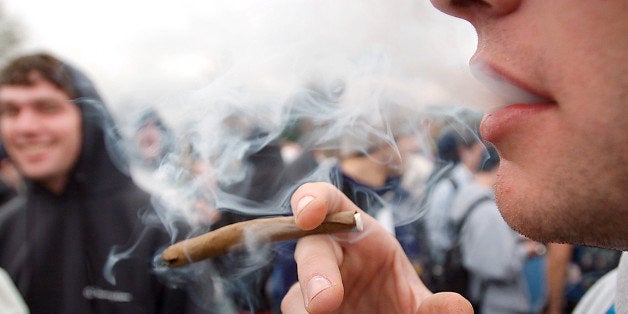
Can a person be too stoned to drive? That's a question that many states -- including Colorado and Washington, both of which now have recreational marijuana laws on the books -- have tried to address in recent legislation.
A recent study published in peer-reviewed medical journal Clinical Chemistry suggests that a marijuana breath test may be a viable way for authorities to test for THC in a motorist, similar to the "breathalyzer" test performed on drivers to determine their level of alcohol intoxication. The breath test could be an alternative to the THC-blood test commonly used, which remains controversial.
According to the study, the researchers collected exhaled breath samples from chronic marijuana users (four times per week or more) and occasional users (fewer than two times per week) after they smoked a 6.8 percent THC cigarette.
The researchers found that THC, the psychoactive ingredient in marijuana that causes the "high" sensation and is generally considered the one that would affect driving ability, was the major cannabinoid found in the breath samples. No breath sample contained THC-COOH, a marijuana "metabolite" that's simply formed in the body after cannabis is consumed. And only one sample contained CBN, or cannabinol, an oxidative degradation product of THC that has some psychoactive properties but is of a far less strength than THC.
For the chronic smokers in the test group, all breath samples tested positive for THC just under one hour after smoking marijuana. As time went on, fewer samples tested positive and by about four hours after smoking, only one chronic user's sample still tested positive.
Among the occasional pot smokers, about 90 percent of breath samples tested positive for THC just under an hour after smoking pot and continued to test positive after about an hour and half later. One occasional smoker had no detectible THC in the breath sample.
"Breath may offer an alternative matrix for testing for recent driving under the influence of cannabis, but is limited to a short detection window," the researchers conclude in their paper. The approximate detection window is thought to be between 30 minutes to two hours after smoking marijuana.
Depending on the quality and potency of the marijuana consumed, the psychoactive effects wear off within three to four hours, with THC levels in the bloodstream peaking at five to 10 minutes after inhalation and then decreasing, according to a study from Marijuana Policy Project.
Currently, THC-blood tests are the norm in most states that have laws regulating marijuana use while driving. They generally dictate that drivers caught with THC in their bloodstream at a level of five nanograms of THC per milliliter of blood are considered "under the influence" and may be subject to penalty.
But unlike blood-alcohol level, which have a direct correlation with a driver's intoxication, blood-THC levels don't necessarily indicate a level of impairment.
In one study, six of 25 participants who had consumed marijuana still tested positive for active levels of THC after a full seven days of abstaining.
Last year Sen. Pat Steadman (D-Denver) spoke out about the issues that make marijuana blood limits problematic while debating Colorado's proposed new marijuana DUI law, citing issues like THC being fat-soluable, so blood limits could remain above the five nanogram limit for days after the user last legally smoked pot, CBS4 reported. The user would not appear stoned, but legally they could still be considered impaired. With this thinking in mind, Steadman tried and failed to exempt medical marijuana patients in the bill.
William Breathes, pot reporter for Denver news site Westword, illustrated Steadman's point dramatically. In 2011, after a night of sleep and not smoking pot for 15 hours, a sober Breathes still tested nearly three times higher than Colorado's legal limit.
To add confusion to the matter, in early 2013 Washington state television station KIRO assembled a group of volunteers, had them smoke pot and set them loose on a driving test course to try and answer the question: How high is too high to drive?
The less-than-scientific results, while entertaining, unfortunately don't add much clarity to the question at hand. A regular smoker of marijuana tested above the legal limit to begin with, yet drove without much of a problem. Two casual smokers also navigated the course without incident. However, after smoking more marijuana, driving ability began to devolve quickly.
In Washington, which passed a marijuana DUI bill in 2012, the enforcement of the law ultimately comes down to common sense. Bob Calkins, a Washington State Patrol spokesman, explained to the Oregonian, "We don't just pull people over and draw blood ... If you're driving OK, we're not going pull you over. But driving impaired is still driving impaired." Watch KIRO's full stoned driving segment here.

